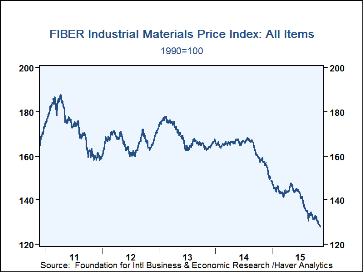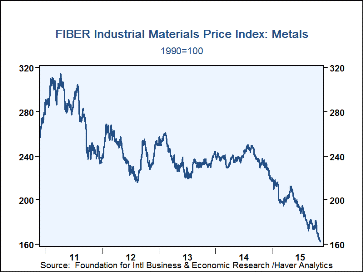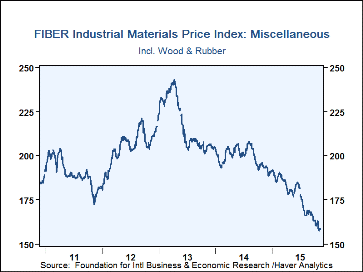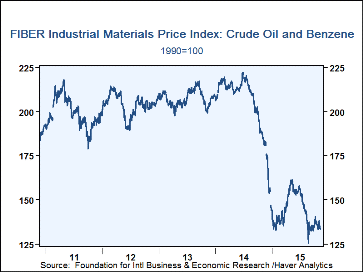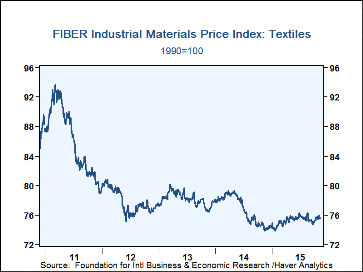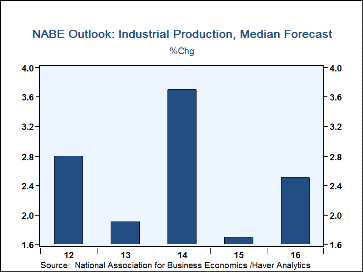 Global| Nov 11 2015
Global| Nov 11 2015FIBER: Industrial Commodity Prices Continue Moving Lower
by:Tom Moeller
|in:Economy in Brief
Summary
Lackluster performance within the factory sector has left industrial commodity prices under pressure. The industrial commodity price index from the Foundation for International Business and Economic Research (FIBER) deteriorated by [...]
Lackluster performance within the factory sector has left industrial commodity prices under pressure. The industrial commodity price index from the Foundation for International Business and Economic Research (FIBER) deteriorated by 2.6% during the last four weeks, leaving prices off 22.3% during the past year. In the U.S. alone, industrial output has fallen in three of the last four months and has risen just 1.3% during the last twelve months. Factory production in the OECD has similarly been a moderate 2.0% during the last year.
Within the sector groupings of prices, the FIBER measures show broad-based weakness. In the metals sector, prices have been falling. Steel scrap prices fell 23.5% during the last four weeks and by 57.3% during the last year. Aluminum prices fell 4.1% m/m (-17.8% y/y) and copper scrap prices also declined 1.5% m/m (-26.5% y/y). Lead prices similarly fell 1.0% over the last month and by 19.6% y/y. In the miscellaneous price grouping, framing lumber prices rebounded 11.4% over the last month but remained off 10.8% y/y. Prices for structural panels similarly rose 4.8% during the last four weeks but remained roughly unchanged during the last year. Natural rubber prices continue to soften, off 5.3% during the last month and 35.6% over the last year. In the crude oil & benzene area, the cost of WTI crude oil continued its downward trend to $43.72 per barrel yesterday. The rate of decline has slowed of late, but prices were off 59.0% y/y. Prices for the petro-chemical benzene have seen support recently, up 2.1% in the last month but off by one-half y/y. Prices in the textile sector have shown comparative strength, nudging up slightly in the last month but remaining down a moderate 2.6% y/y. Cotton prices have wobbled sideways during this year but were down 22.0% y/y. Conversely, burlap prices rose 13.3% y/y and have been rising since the fall of 2014.
Support for commodity prices may be on the way. The current industrial output projection from the National Association for Business Economics calls for 2.5% U.S. production growth in 2016. During the last ten years, there has been a 52% correlation between the three-month change in prices and the change in industrial output.
Commodity price data can be found in Haver's DAILY, WEEKLY, USECON and CMDTY databases.
| FIBER Industrial Materials Price Index (1990=100) | 11/11/15 | 1-Mth % | 3-Mth % | 6-Mth % | Y/Y % | 2014 | 2013 |
|---|---|---|---|---|---|---|---|
| All Items | 128.09 | -2.6 | -9.2 | -10.7 | -22.3 | 163.5 | 169.0 |
| Textiles | 75.2 | 0.7 | -0.3 | 0.8 | -2.6 | 76.8 | 78.2 |
| Cotton (cents per pound) | 60.45 | -0.1 | -4.4 | 1.9 | -22.0 | 73.6 | 79.6 |
| Metals | 181.3 | -6.8 | -14.3 | -18.0 | -31.1 | 237.8 | 236.2 |
| Aluminum ($ per metric ton) | 1,485.5 | -4.1 | -9.7 | -16.7 | -17.8 | 1,864.9 | 1,846.7 |
| Copper Scrap (cents per pound) | 223.72 | -1.5 | -9.3 | -15.7 | -26.5 | 311.7 | 332.3 |
| Steel Scrap ($ per ton) | 152.33 | -23.5 | -38.9 | -32.8 | -57.3 | 358.3 | 345.8 |
| Crude Oil & Benzene | 133.8 | -0.6 | -12.1 | -3.4 | -37.6 | 205.2 | 207.7 |
| Crude Oil (WTI, $ per Barrel) | 43.72 | -2.8 | -16.0 | -13.9 | -59.0 | 93.5 | 97.9 |
| Miscellaneous | 167.5 | -2.5 | -10.2 | -16.1 | -20.5 | 199.6 | 218.3 |
| Framing Lumber ($ per 1000 board ft.) | 331 | 11.4 | -5.2 | -4.9 | -10.8 | 383 | 383 |
| Natural Rubber (cents per pound) | 95.48 | -5.3 | -22.4 | -29.5 | -35.6 | 140.2 | 190.0 |
Tom Moeller
AuthorMore in Author Profile »Prior to joining Haver Analytics in 2000, Mr. Moeller worked as the Economist at Chancellor Capital Management from 1985 to 1999. There, he developed comprehensive economic forecasts and interpreted economic data for equity and fixed income portfolio managers. Also at Chancellor, Mr. Moeller worked as an equity analyst and was responsible for researching and rating companies in the economically sensitive automobile and housing industries for investment in Chancellor’s equity portfolio. Prior to joining Chancellor, Mr. Moeller was an Economist at Citibank from 1979 to 1984. He also analyzed pricing behavior in the metals industry for the Council on Wage and Price Stability in Washington, D.C. In 1999, Mr. Moeller received the award for most accurate forecast from the Forecasters' Club of New York. From 1990 to 1992 he was President of the New York Association for Business Economists. Mr. Moeller earned an M.B.A. in Finance from Fordham University, where he graduated in 1987. He holds a Bachelor of Arts in Economics from George Washington University.


